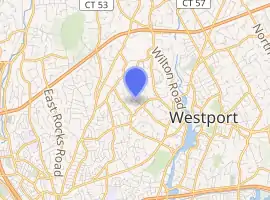Earthplace
Earthplace is a nature discovery and environmental learning center in Westport, Connecticut, whose purpose is to build a passion and respect for nature and a more sustainable future for our community. Earthplace blends science, nature conservation, and education into pathways for experiencing and learning about the natural world.[2]
| Earthplace, The Nature Discovery Center | |
|---|---|
 | |

| |
| Type | Natural history museum, nature center and wildlife sanctuary |
| Location | 10 Woodside Lane Westport, Connecticut, USA |
| Coordinates | 41°08′45″N 73°22′53″W |
| Area | 62 acres (25 ha) |
| Created | 1958[1] |
| Designer | John Ripley Forbes |
| Website | www |
Features
Natureplace is the museum room that features interactive nature displays, hands-on activities and a small video theater. Five large wildlife dioramas depict animals and plants found in various seasons and ecosystems in Connecticut. The adjacent Smilow Family Ecology Resource Lab features nature exploration activities and a diorama of backyard birds.
Earthplace houses a large collection of rescued wildlife that are exhibited as species ambassadors, including bald eagles, hawks, turkey vultures, a black vulture, a kestrel, several types of owls, a box and wood turtle, a black rat snake, and little brown bats. Due to their injuries, these animals cannot be released back into the wild. Several domestic animals are used in public programs, including rabbits, ferrets, guinea pigs, and Madagascar hissing cockroaches. One of the most popular domestic animals, Barney the Burmese python, was put down in December 2011 at over 26 years old.
Earthplace maintains a 62-acre (25 ha) sanctuary, which is the largest open-space area in Westport. Trails cross areas of wetlands, ponds, streams, hardwood forests and meadows. Sightings of rabbits, chipmunks, deer, box turtles, wild turkeys, mink, bullfrogs, coyotes, wood frogs and many birds are regularly made on the trails.

The Native Plants Courtyard was designed in 1960 by landscape architect Eloise Ray to highlight plants native to southwestern Connecticut. Species include bloodroot, trillium, jack-in-the-pulpit, wild ginger, Solomon's seal, yellow lady's slipper and prickly pear cactus.
A large bronze statue of a mother bear and two cubs by noted animal sculptor Anna Hyatt Huntington is placed near the entrance to two major trails.
Environmental activities
Harbor Watch at Earthplace is a water quality monitoring program supported by Earthplace. Staff scientists work with volunteers to take water samples from area streams and rivers, which are then analyzed in the center's state-certified laboratory. Harbor Watch also monitors the population of juvenile benthic fish in the Norwalk harbor.
The Mary Eason Swett Wildlife Rehabilitation program rescued hundred of local animals each year, and had the goal of releasing each animal back into the wild. The program was discontinued in 2011.
Education
The Earthplace Nursery School has been operating on the grounds since 1967 and is licensed by the state of Connecticut.
Founded in 1961, the Junior Staff program for middle and high school students focuses on natural science education, community service and personal growth. It has had over 500 participants, and each year has a different environmental focus that is taught by staff naturalists.
Earthplace operates an accredited summer camp program, and offers after-school, school and scout group programs.
History
Earthplace was founded in 1958 as one of the many science and nature museums being developed around the country by groups led by naturalist John Ripley Forbes.
The Mid-Fairfield County Youth Museum opened in 1961. In 1973 the organization changed its name to the Nature Center for Environmental Activities. In 2002 the name was changed to Earthplace, The Nature Discovery Center. In 2007, the 22 acre Partrick Wetlands open space was donated to Earthplace.
See also
References
- "Earthplace - The Nature Discovery Center, Westport CT". Retrieved 2010-04-11.
- Trisha Blanchet (1 November 2004). Insiders' Guide to Fairfield County. Globe Pequot. pp. 117–. ISBN 978-0-7627-2727-8. Retrieved 4 December 2011.